Elephant Ear: Plant Care and Growing Guide for Indoors and Outdoors
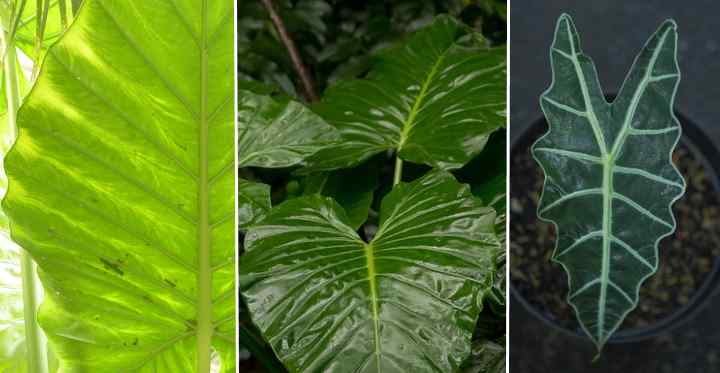
Elephant ear plants can refer to several species of tropical plants grown for their enormous triangular-shaped leaves. Elephant ear plants grow from ‘bulbs’ or tubers in the ground in warm climates. You can also grow elephant ear plants indoors to add dramatic foliage to any bright room. The most common species of elephant ears are plants in the genera Alocasia, Caladium, Xanthosoma and Colocasia.
Elephant ears are fast-growing perennial plants. In USDA zones 9 through 11, elephant ears thrive in tropical gardens in partial shade or full sun. In colder climates, you can grow elephant ear plants in the ground as annuals. Or you can dig up the elephant ear bulbs and store them indoors for replanting the following spring. As with most types of tropical plants, elephant ears thrive in pots in indirect sunlight and average room temperatures.
Depending on the elephant ear species, the plants are known by various common names. For example, plants in the genus Alocasia are called the African mask plant, Kris plant, and Mayan mask upright elephant ear plant. Many varieties of Colocasia plants are called Taro plants.
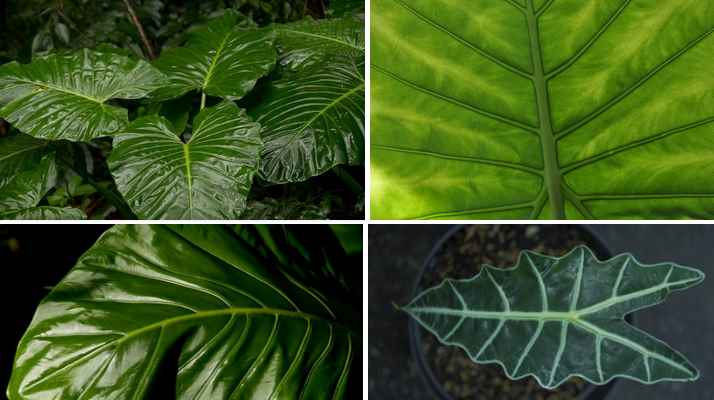
Leaves of various elephant ear plants (alocasia species)
Most elephant ear plants have lush green leaves with pronounced bright white or creamy white veins. Some varieties of elephant ears (Colocasia) have purple leaves, giving the tropical plants a dramatic appearance. The giant elephant ear leaves on some plant types have a shiny green upper side and reddish-purple underside.
This article is a complete guide to caring for elephant ears indoors and outdoors. In addition to advice on growing elephant ears, you’ll get handy tips on resolving many issues affecting the plants’ growth.
How to Care for Elephant Ear Plant
To care for elephant ears, grow the plants in moist, well-draining soil that is slightly acidic. Elephant ear plants require plenty of humidity and need regular watering to grow fast. Apply a high nitrogen fertilizer regularly to encourage growth. Growing indoors, put the elephant ear plant in indirect sunlight. Outdoors, grow elephant ears in full to partial sun.
Elephant Ear Bulbs
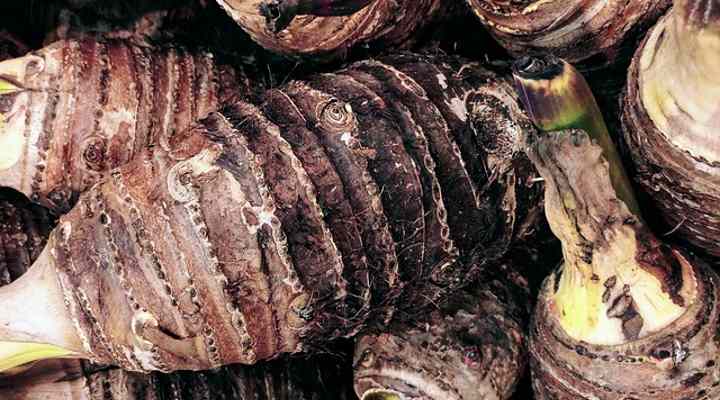
Elephant ear tubers (Caladium tubers)
Elephant ear plants have tuberous roots that many people refer to as elephant ear bulbs. Elephant ear plants are not cold hardy. So, if you plant the elephant ears in colder climates, you’ll need to overwinter the bulbs indoors. When digging up elephant ear bulbs, it’s vital to avoid damaging the tubers.
To winterize elephant ear plant bulbs after fall, rinse them after digging them up. Remove any foliage from the roots. Leave the elephant ear bulbs in a dark, well-ventilated warm place for a week to dry. Wrap the bulbs in paper and store them in a cool, dry place until it’s time for planting in spring.
How to Plant Elephant Ears
Plant elephant ears in the ground in spring after the threat of frost has passed. It’s vital to ensure that your garden’s soil temperature is at least 65°F (18°C) to avoid damaging the elephant ear bulbs. Dig a hole about 5” (12 cm) deep and plant with the elephant ear bulb’s pointed side facing up. Cover with soil and water regularly.
Alternatively, you can plant elephant ears in pots in early spring before transferring them to a sunny spot in your garden. Most Alocasia, Colocasia, Xanthosoma and Caladium varieties prefer full sun to partial shade. The taro plant Colocasia esculenta ‘Black Magic’ prefers growing in full shade.
Elephant Ear Care Guide
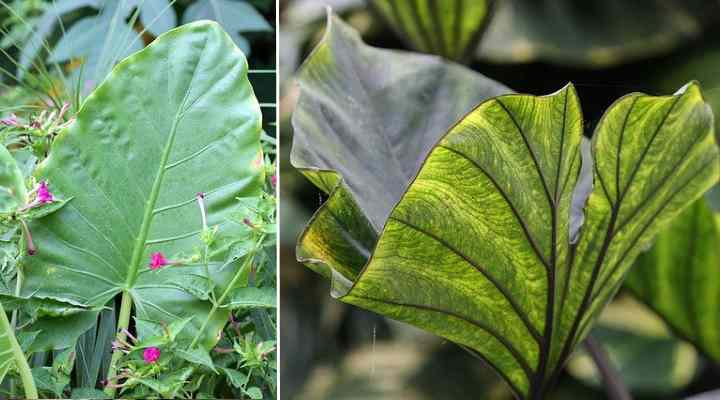
Elephant ear (Colocasia) leaves
Let’s look in more detail at how to grow elephant ear plants to add stunning tropical foliage to your garden landscape or home interior.
Where to Plant Elephant Ear Bulbs
The best place to plant elephant ear bulbs outdoors in your garden is in a sunny spot with afternoon shade. In hot, dry climates, elephant ears grow best in filtered sunlight so that giant leafy plants don’t wither in the heat. Make sure that the ground for elephant ear plants retains plenty of moisture.
The mammoth elephant ear leaves are also prone to catching the wind. So, it would be best to choose a location that provides the ornamental leaves protection from strong winds. Generally, purple elephant ear plants with dark leaves grow best in the shade.
How to Grow Elephant Ears in Pots
Many varieties of elephant ears are suitable for growing in large containers. The best place to grow a potted elephant ears plant is in bright, indirect sunlight. To grow an elephant ear plant indoors, you’ll need warm temperatures, plenty of humidity, and enough space. Remember that elephant ear leaves can grow up to 3 ft. (1 m) long and 2 ft. (0.6 m) wide.
The best elephant ear houseplants to grow indoors in pots are Alocasia ‘Polly,’ Colocasia ‘Black Magic,’ ‘Cranberry Taro,’ Alocasia ‘Frydek,’ and the Elephant Ear ‘Tiger’ (Alocasia zebrina).

Elephant ear plant – Alocasia ‘Polly’ (Alocasia amazonica ‘Polly’)
Related reading: How to care for Alocasia plants indoors.
Light Requirements for Growing Elephant Ear Plants
Grow varieties of Alocasia, Caladium, Xanthosoma and Colocasia plants in bright sunlight and partial shade. When growing potted elephant ears inside, it’s crucial to protect the foliage from direct sunlight. The intense sun’s rays can bleach or discolor the stunning ornamental leaves. At a south-facing window, protect the elephant ears with a sheer curtain.
Typically, species of elephant ear plants can withstand direct sunlight growing outdoors. Elephant ear plants usually need to grow outside in partial shade in hot, dry climates.
Suppose your region doesn’t have high humidity. In that case, you will have to provide plenty of water if humidity is low and you have hot, intense sunshine.
The Best Soil for Elephant Ears

Grow elephant ears in moist but well draining soil. In the picture: Elephant ears Xanthosoma sagittifolium
Elephant ears thrive in soil rich in organic material, drains well, and retains plenty of moisture. To grow elephant ears in pots, use a potting mix suitable for aroids. Mix 5 parts bark, one part perlite, and one part peat moss for growing potted plants. The organic matter holds moisture, and perlite improves drainage.
When growing in sunny backyards, elephant ear plants need plenty of organic matter in the ground. You can work in compost to provide plenty of nutrients and hold in moisture.
Although elephant ear plants prefer moist soil growing in the ground or pots, the blubs don’t like sitting in waterlogged soil. Therefore, well-draining, loose organic-rich soil and plenty of watering should keep your elephant plants happy.
How to Water Elephant Ear Plants
Water elephant ear plants regularly to keep the soil slightly moist. During spring and summer, you may have to water potted elephant ear plants every day. Always let soil moisture levels guide you when to water elephant ear plants. Water when the top layer of soil is almost dry, give the potting mix a thorough watering.
Outdoors, ensure the Alocasia and Colocasia plants grow in soil that’s always moist. During winter, you can water elephant ears in your garden less frequently.
It’s impossible to overwater elephant ear plants if you only water them when the top part of the soil partially dries. Most species of elephant ears thrive in wet conditions and are not drought-tolerant plants. However, you must take care not to overwater Alocasia and Colocasia plants.
Some of the larger Colocasia varieties are plants native to swampy areas. They thrive in water gardens with the tuber roots submerged continuously in water.
Related reading: The ultimate houseplant watering guide.
Temperature Requirements for Elephant Ears
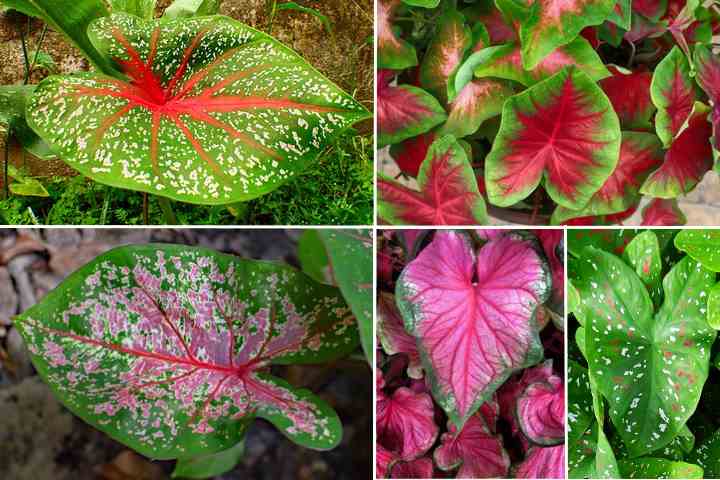
Elephant ear plants thrive in warm temperatures. In the picture: leaves of various caladium species
Elephant ear plants are heat-loving tropical plants that don’t tolerate the cold. The ideal temperature range to grow elephant ears is between 65°F and 75°F (18°C – 24°C). Over winter, you can store elephant ear bulbs in a cool basement that is between 45°F and 55°F (7°C – 13°C).
Most Colocasia, Alocasia, Caladium, and Xanthosoma varieties grow outdoors in USDA zones 9 through 11. A few types of elephant ears are cold-hardy in zone 7 or 8. For example, the popular Colocasia esculenta ‘Blue Hawaii’ and Alocasia ‘Portora’ grow outside in zone 7.
Elephant Ear Care — Getting Humidity Right
Elephant ear plants have high humidity needs growing indoors and outside. Potted elephant ear houseplants need above-average air moisture levels indoors. You can increase humidity for elephant ear plants by sitting the plant pot on a pebble tray with water in it. Or you can boost room humidity with a humidifier.
You can mist elephant ear leaves between watering to increase moisture levels. However, the lush tropical foliage benefits better from air humidity rather than leaf misting.
If you live in zones 9 through 12, humidity is rarely an issue growing elephant ears in the ground. If you live in a dry climate, you will need to water the thirsty plant frequently—possibly even every day—to prevent it from drying out.
How to Fertilize Elephant Ears
Elephant ear plants are heavy feeders. All species of Alocasia, Caladium, Xanthosoma, and Colocasia benefit from extra nutrients. To encourage healthy foliage growth, fertilize elephant ear plants with a nitrogen-rich fertilizer. A houseplant fertilizer with an NPK ratio of 20-10-20 should be suitable.
Fertilize elephant ear houseplants every two weeks during spring and summer. Stop ‘feeding’ the plant at the end of August.
Yellow leaves could mean that the elephant ears plant needs more micronutrients. Or you could sprinkle Epsom salts around the plant’s base every four weeks to improve the color of leaves.
Pruning Elephant Ear Plants
The elephant ear plant benefits from pruning to remove dead or dying leaves. Use sterile tools to cut the yellowing leaves off at the base of the plant. Alocasia and Colocasia plants continuously produce new leaves. As new ones appear, you can snip off the older leaves to encourage healthy growth.
If you grow elephant ear plants as annuals in colder climates, they will die back in late fall. Remove all the stalks from the plant, dig up the elephant ear bulbs, and dry them in a dark, warm place to winterize them. You can then store them during winter in a cool location.
Repotting Elephant Ear Plants
Most indoor elephant ear plants benefit from annual repotting. It is always best to grow potted elephant ear plants in larger-than-usual pots. The large elephant ear bulbs need plenty of room to grow. Also, due to the enormous leaves, a large container helps keep the plant stable.
When repotting the mammoth elephant ears plant, take care to remove the bulb gently from the pot. Shake off excess dirt and check the root for signs of decay or disease. Choose a large pot, one or two sizes larger than the previous one. Plant elephant ears bulb about 3” to 5” in the soil with part of the rhizome root visible at the soil line. Water thoroughly and place the pot in a sunny location.
How to Propagate Elephant Ears
Elephant ear propagation is by root division. Elephant ear plant bulbs multiply by producing baby bulbs. To grow more elephant ear plants, carefully dig up the rhizome roots. Look for the small baby tubers attached to the main bulb and cut them off using a sterile sharp knife.
Plant the smaller baby elephant ear plant bulbs in a pot to get established. Use a light, porous potting mix to plant the small bulbs. Always plant the tuber with the pointed end facing up. Keep the soil consistently moist. When the ground temperature is at least 60°F (15°C), and new growth appears above the soil, you can plant the elephant ear bulbs outside in the ground.
The tuberous root can also spread in the ground where smaller plants—called stolons—start growing.
Pests Affecting Elephant Ear Plants
Common pests affecting Alocasia and Colocasia plants include aphids, spider mites, and mealybugs. Get rid of bugs from elephant ears by mixing 2 tsp. neem oil, 1 tsp. liquid dish soap, and 1 quart (1 l) of water in a spray bottle. Liberally spray the neem oil solution on the large heart-shaped leaves and allow them to dry. Use neem oil once a week to get rid of any plant pests.
Pest infestations can cause the edges of elephant ear plant leaves to turn brown. But it’s good to note that brown leaves on elephant ear plants can also indicate a nutrient deficiency, lack of water, or growing in cold conditions.
Diseases Affecting Elephant Ear Plants
Taro plants and African mask plants can be affected by fungal diseases such as root rot and leaf spot. The best way to prevent fungal infections is to get watering and humidity levels right.
For example, fungal leaf spot is the result of too much humidity. The giant leaves develop reddish-purple or light brown spots. To avoid fungal foliage issues, always water the ground, not the leaves. Also, ensure that there’s enough air circulation around the large leaves to allow moisture to evaporate.
Although some elephant ear plants grow in water, many species don’t like standing in soggy soil. Excessive soil dampness causes the elephant ear bulbs to rot and decay. This can result in soft or mushy stems and roots.
The best way to prevent elephant ears plants from disease is to use good irrigation practices. Only water the ground enough to keep it moist and ensure plenty of ventilation and air circulation.
Are Elephant Ear Plants Toxic?
According to the University of Wisconsin-Madison, the leaves of Elephant ear plants (Colocasia, Alocasia, and Xanthosoma) are edible but they must be cooked first. The leaves contain calcium oxalate crystals that cause severe skin irritation and they must be cooked first.
Some species of elephant ears that are also called taro and belong to the Colocasia genus are edible and their tubers are cultivated for consumption. However taro roots must be cooked before consumption.
According to the ASPCA, Elephant ears that belong to the Caladium genus are poisonous to dogs, cats, and horses and can cause oral irritation due to their insoluble calcium oxalates.
If you are unsure about the type of elephant ear plant – it’s best to avoid ingesting it.
Why Do Elephant Ears Turn Yellow?
Too much sunlight, growing in the shade, or overwatering can cause elephant ear plant leaves to turn yellow. You should remove the yellowing leaves by cutting them off at the base of the stem. You should resolve the underlying problem to prevent more leaves from turning yellow.
It’s also good to note that yellow elephant ear leaves occur as leaves naturally die. So, if you only have one Alocasia or Colocasia leaf turning yellow, you probably have nothing to worry about.
Why Do Elephant Ears “Cry”?
Elephant ear plants seem to cry when droplets of water appear at the large arrow-shaped leaves’ tips. This plant’s weeping effect is due to too much water. As long as there are no other signs of overwatering, you shouldn’t worry too much. Just hold off watering for a few days to stop water dripping from the leaves.
Types of Elephant Ear
Elephant ear plants are famous for their huge tropical leaves. Plants commonly called elephant ears are from four tropical plant species—Alocasia, Colocasia, Caladium, and Xanthosoma. Here are a few stunning varieties of elephant ear plants you can grow to add a tropical atmosphere to your yard or an indoor setting.
African Mask Plant (Alocasia x amazonica)—This popular evergreen perennial elephant ear has dark green triangular leaves with striking creamy-white pointed veins. Grow the African mask plant as an ornamental houseplant or outside in zones 10 through 12. The Alocasia ‘Polly’ is the compact variety of the Alocasia amazonica.
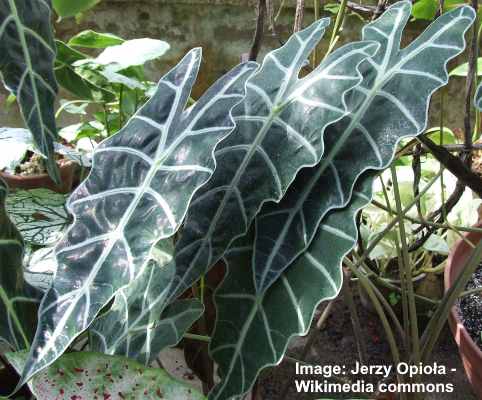
Elephant ear Alocasia x amazonica
Mammoth Elephant Ears (Alocasia macrorrhiza)—The giant elephant ears plant has enormous green leaves that grow between 3 and 6 ft. (1 – 2 m) long and up to 4 ft. (1.2 m) wide.
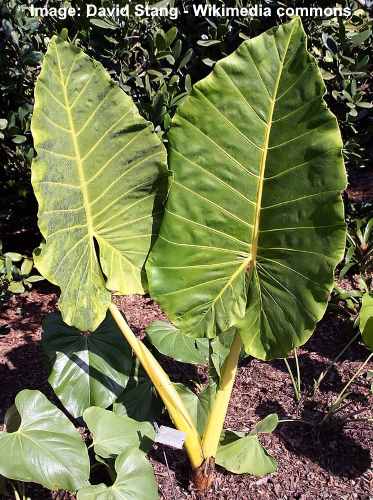
Elephant ear Alocasia macrorrhiza ‘Lutea’
Alocasia zebrina—This unusual houseplant has large arrowhead leaves and stalks that have zebra-like markings. Grow the eye-catching elephant ear Alocasia zebrina in pots near a sunny window but protected from direct light.
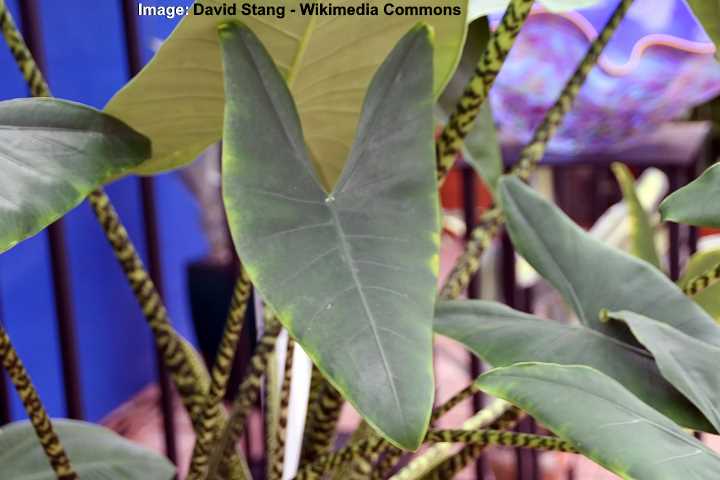
Elephant ear Alocasia zebrina
Taro ‘Illustris’ (Colocasia esculenta ‘Illustris’)—A stunning elephant ear plant with purplish leaves and lime green veins. Outdoors, this impressive elephant ear plant grows up to 5 ft (1.5 m) tall and 4 ft. (1.2 m) wide.
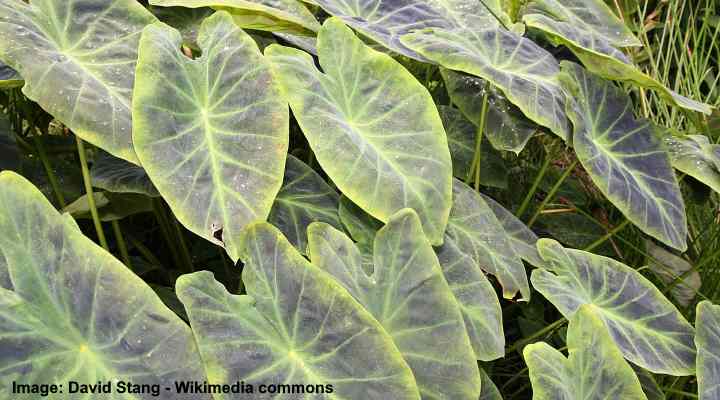
Elephant ear Colocasia esculenta illustris
Taro ‘Blue Hawaii’ (Colocasia esculenta ‘Blue Hawaii’)—This giant elephant ear plant has large green leaves with purple-red veins and stalks. The elephant ear Colocasia ‘Blue Hawaii’ is one of the few elephant ears that is cold hardy in zones 7 through 11.
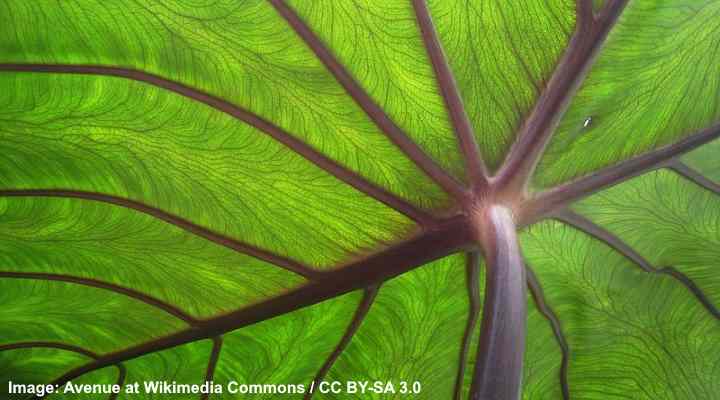
Elephant ear Colocasia esculenta ‘Blue Hawaii’
Discover many other beautiful types of elephant ears.
Related articles:
